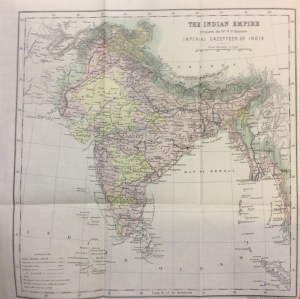THE IMPERIAL GAZETTEER OF INDIA.
Second edition.
Trübner & Co., London, 1885-1887
In-8 p. (mm. 218x138), 14 volumi (di cui 1 di Indice), mz. pelle editoriale (con abras. e picc. mancanze; tracce d'uso ai piatti), ogni vol. di ca. 460/570 pagg. Seconda edizione, completa, di questa grandiosa opera statistica dell'intero Impero Britannico in India. La prima fu pubblicata in 9 volumi nel 1881.The publication of "The Imperial Gazetteer of India" marks the completion of the largest national enterprise in statistics which has ever been undertaken. This gigantic work has been carried out under the uninterrupted direction of Dr. Hunter, its original designer, from the initial stage of local inquiry in each of the 240 Districts of India to the final arrangement of the results in an alphabetical form.. The article "India" in volume IV (volume VI in this second ed.) is the touchstone of the work, and proves clearly enough the sterling metal of which it is wrought.. It is, moreover, the only attemps that has ever been made to show how the Indian people have been built up, and the evidence from the original materials have been for the first time sifted and examined by the light of the local researches in which the author was for so long engaged.. (see The Times, May 26, 1881).L'opera (che si occupa anche di geografia, storia, economia e governo dell'India) è così composta: 1° Abar to Balasinor - 2° Balasor to Biramganta - 3° Birbhum to Cocanada - 4° Cochin to Ganguria - 5° Ganjam to Indi - 6° India (pp. 747) - 7° Indore to Kardong - 8° Karens to Madnagarh - 9° Madras Presidency to Multai - 10° Multan to Palhalli - 11° Pali to Ratia - 12° Ratlam to Sirmur - 13° Sirohi to Zumkha - 14° Index. Ogni volume contiene una carta geografica a colori, più volte ripieg. Sir William Wilson Hunter (1840-1900), funzionario e pubblicista, si laureò nell'università di Glasgow e nel 1861 entrò nell'amministrazione dell'India, dove rimase 26 anni. Oltre a occupare varie cariche amministrative, fece importanti pubblicazioni economico-statistiche. Il viceré lord Mayo lo incaricò di un vasto studio statistico di tutta l'India e nel 1871 lo nominò direttore generale della statistica. Il H. quindi ideò il vasto Imperial Gazetteer of India', in cui si raccolse vasta messe di notizie su ogni provincia dell'impero, e mentre diresse tutto il lavoro, curò direttamente i volumi sul Bengala e l'Assam. In tutto furono pubblicati 128 volumi, che il H. riassunse nel 1881 in 9 volumi (IV ed., volumi 26, Oxford 1931). Lasciata l'India nel 1887, si stabilì presso Oxford e divenne collaboratore del Times. Così Enciclopedia Treccani,XVIII, p. 605.Tutti i testi della ns. raccolta sono ben conservati.



